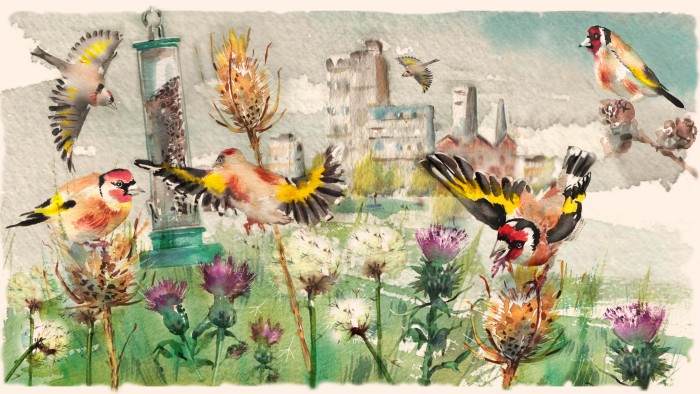Stay informed with free updates
Simply sign up to the House & Home myFT Digest — delivered directly to your inbox.
In 1486, Dame Juliana Berners published a seminal list of collective nouns. Controversially, she included a “drunkenness of cobblers” and a “disworship [disgrace] of Scots”. This must have been a bitter blow for Caledonian shoemakers. She was kinder to goldfinches. A flock of them was “a charm”, she wrote.
The pretty plumage, fluent song and beguiling habits of these small finches were entrancing people long before Dame Juliana put quill to parchment. Happily, more Britons can now enjoy their presence. Thanks to feeding stations in gardens and on balconies, their population is booming.
Easter is a good time to watch goldfinches for both pragmatic and folkloric reasons. The bevy of birds that stay in the UK year round is swelled by the return of individuals that overwintered on the continent. Pairs start building the first nests just after Easter Sunday, according to the British Trust for Ornithology.
Goldfinches’ stronger association in European Christian mythology is with Good Friday. According to one legend, a compassionate goldfinch tried to pluck the thorns from the cruel crown of the crucified Christ. Its white face was stained red in the process.
Goldfinches therefore crop up in numerous Renaissance paintings of the Madonna and Child. The bird is present as a harbinger of the Passion. But these are cheering works for the most part. The goldfinch appears to be there voluntarily, having dropped in to spend quality time with the infant Jesus.
“The Goldfinch”, a Dutch Golden Age painting, is now better known. It is the MacGuffin in Donna Tartt’s 2013 novel of the same name. It is a decent tale. But I hate this picture. The goldfinch is chained to its perch, an intolerable way to treat a bird.
The painting is a reminder of the huge inroads that bird catchers made into wild songbird populations to supply the pet trade. In 1860, for example, 132,000 migrating goldfinches were reportedly caught for this purpose near Worthing, Sussex.
To put this in context, the entire UK population is currently around 1.7mn pairs. That still represents a welcome 150 per cent increase since 1995, according to BTO data.
During that period, intensive agriculture has depleted the scrubland, fallow and field margins songbirds depend on. Goldfinch numbers have risen because the birds, like so many supposedly rural animals, are finding towns and cities more congenial than the country.
To my delight, a flock established itself in my London suburb a couple of years ago. The birds are gregarious, garrulous and flit from one place of refreshment to another, rather like human Londoners on a summer evening. I have lured them into my garden with handouts of nyjer seed (the birds, not the humans).
Goldfinches have a gourmand’s appetite for these small grains. It worries me that sooner or later an overstuffed bird will explode in a puff of feathers, like an avian Mr Creosote.
Jon Carter of the BTO puts me right. I am mistakenly fixating on feeding sessions longer than those of some other garden birds, such as blue tits, he says. These tend to fly to and from bird feeders quickly, repeatedly and singly. He says: “In contrast, you often see two or three goldfinches feeding at one time. The logic of the behaviour is that one of them is always keeping an eye out.”
A dozen or so goldfinches descended on my lawn last autumn to eat dandelion clocks. Begone inadequate lawncare shame! They resolutely ignored the teasels and sunflowers I had grown for them. I hope you have better luck if you try the same experiment. Thistles are also recommended.
“Goldfinches are seed-eating specialists,” says Charlotte Bartleet-Cross, of the charity SongBird Survival, “Their beaks are quite thin so they can extract the seeds from plants other birds cannot deal with.” Tough, stubby feathers protect their faces from plant spines.
In the US and Canada, American goldfinches occupy the same niche as their European cousins. The male is a handsome yellow and black bird. Correspondence with US Nature Therapy readers suggest they are less evident in urban and suburban settings. But thankfully, the species appears to have stymied displacement attempts by European cousins released by irresponsible bird fanciers.
Growth in the population of European goldfinches back home is something else to celebrate. In a small way, it validates the idea that our individual actions can support wild animals threatened by impersonal economic forces.
Dame Juliana would approve, I hope. It is easy to view this huntin’, hawkin’ noblewoman as a part of a quaint Middle Ages of chivalry and plainchant, rendered safe by the passing of centuries. In reality, she was writing at a time of regime change and communal violence.
If she took pleasure in goldfinches in her turbulent era, so may we in ours.
Find out about our latest stories first — follow @ft_houseandhome on Instagram
Read the full article here

